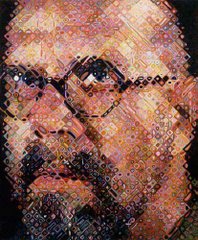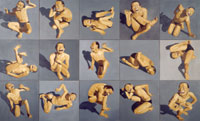Last night I had the honor to be a part of my best friend's wedding. The best part of being in a wedding is the view that comes with your position. Not the 200 guests in chairs, but you get to peer into the faces of the bride and groom. As the title of "Maid of Honor" or "Best Man" declares, you must be exactly that to the bride and/or groom to have such an excellent vantage point.
Not only did I have the best view of the bride and groom, but I was very near in proximity to the unique robe that the minister was wearing. He was an elderly man, the patriarch of the groom's missionary family. His robe was white cotton with flowing sleeves. The pride of the religious garment was the emblem made of colored cross-stitch thread sewn onto the chest. The crafty stitching sat just below the collar of his white cotton turtleneck, which peered out of the robe's V-shaped neckline. The embroidered symbol was a image of a hand held with the palm facing upward. A fire-engine red heart hovered over the palm, and an orange-yellow mixture of thread depicted flames hovering above the heart. Letters, outlines of black stitching, encircled the assortment of symbols. It was apparent that this robe, so unique in its imagery and primitive craftsmanship, must have great significance to the man clad in it. I have never seen anything like it before. One could easily say that the minister was wardrobed in Christian kitsch.
Prior to reading Spackman's book I would have been quite judgmental of minister‘s taste in robes, not because I was raised in a robe-free church, but for artistic reasons. I might have lamented for the bride, aware that the flaming heart would be front and center of many of her wedding pictures. (I might have grieved even though she possesses a genuine ability to laugh at unexpected situations in sort of an ironic British way. May I interject a note here? My brother jokingly insists that when it comes to kitsch the presence of flames can improve upon any image--be it an ace of spades or a leaping tiger. Perhaps this is true of contemporary kitsch, within the unique kitsch economy.) After just a few days of reflecting on A Profound Weakness, and the appearance of a very memorable robe, I found myself becoming more sympathetic towards kitsch and its many forms.
Now for the protestant slant that I am apt to present with every turn of my blog: When I reflect on the art-canon of the Protestant church I have visions of precious moments, plastic crosses, and dancing vegetables...um, dancing in my head. Protestant art is undeniably influenced by the era in which we live--an era of consumerism, mass-production, and national affluence. These characteristics are furthered by the culture of entertainment, convenience, and marketing of the United States. Of course, there was a time when Protestants were making art uninfluenced by these contemporary cultural factors, but I would like to focus on where we, as art-conscious Protestants, are right now.
Right now we must admit that there is a huge amount of mass produced decorative, sentimental, or amusing objects marketed directly to Christians, with a special niche for Protestant Christians. Somehow, whatever the things are, they are meant to be Protestant in appeal. Christians bookstores are commerce centers for Christian kitsch. For example, one can classify a large category of Christian kitsch as being a combination of nature imagery and the words of a Bible verse or hymn. This example may seem vague, but consider how often the combination occurs: bookmarks, coffee cozies, hot pads, coasters, mugs, mouse pads, wall hangings, posters, greeting cards, business cards, t-shirts, key chains, figurines, spectacle cases, Bible covers, ornaments, et cetera. Does any of this stuff say anything about our faith?
That question can provoke heated debate--I have gone through numerous rounds with my Mother. Nevertheless (sorry, Mom), I will boldly declare that Christian kitsch does not say anything about my faith as a Christian, in and of itself. A critic may counter, “What about the Bible verses? What about the words of the hymns? Doesn’t that profess truth that you believe in?” I have respond, “No, it doesn’t.” My faith is not limited to, nor is it contingent upon, snippets of Bible, out of context and out of reverence, adjoined to knick knacks. The truth of the Bible is whole, it cannot be divided for the sake of marketing. Fine art, created by artists gifted by God, is the materialization of theological truth, which transcends the material world. Technically beautiful and conceptually true fine art conveys my faith with much more accuracy. I am not saying that it is not possible to use the Bible in art--Surely Handel’s, Messiah expressed his Christian faith in ways that no other medium could. But one must admit that Handel’s music presents Christian faith clearer than a coffee cozy with Psalms 100 laser printed on it--along with some pansies.
My conclusion about kitsch, after contemplating the minister’s robe, Spackman’s A Profound Weakness, and my own biases over the past few days, is that there is a sort of catch twenty-two in effect. On the one hand, if it were possible to eradicate all Christian kitsch, it would be tempting to jump at that chance. I feel that the focus on kitschy objects among Christians makes trite our Christian worldview. Kitsch hinders the Christian artist from being taken seriously by those in the Protestant Church who aren‘t educated in art, and who are willing to settle for art with a Christian veneer, however inferior or inappropriate. Kitsch detracts from good art, and it is limiting in its ability to present truth, whereas fine art can present truth very well.
On the other hand, when people have appropriate expectations of kitsch, that is, they accept kitsch as a memory place-holder, and not a representation of fine art, then the existence of kitsch is justified and appropriate. Kitsch, used in this way, can even be an important way to pass tradition and heart-warming sentiment--as in the case of the preacher‘s robe at my best friend‘s wedding. As a part of the minister’s homily during the wedding ceremony he explained that he wore his robe intentionally as an emblem of love. The symbol of the hand, heart, and flame is the Geneva Symbol, traditionally representing Christian love.
At this point I must ask myself two questions of grave importance: Say we all purged the world of kitschy objects, would that mean no elderly man wearing a flaming heart and hand on his robe at my best friend’s wedding? How would a world without that robe feel to me? I mean, I am not very sentimental, but in the time that I have taken to write this post, the idea of a flaming robe has really grown on me unexpectedly. It’s a good thing I don’t sign my real name to this blog.
Saturday, December 30, 2006
Subscribe to:
Comments (Atom)











